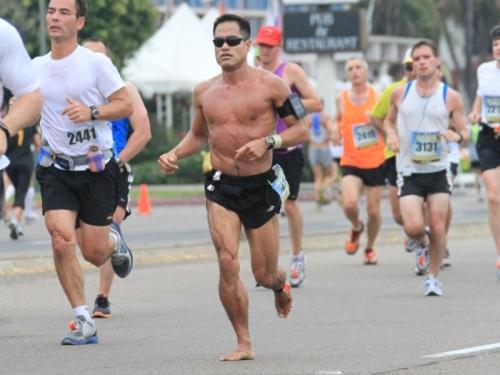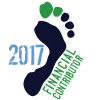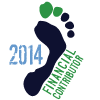
MemberBlog of the Week -
Boston Bound
ByBarefoot Glen
"Ouch, that looks painful" went through my mind as I paced in back of a barefoot runner for several minutes at the San Diego Rock 'n' Roll Marathon last year. He was one of several barefoot runners I saw during the race. I was curious enough to Google the topic that evening, and after my research I was surprised to find myself thinking, "this totally makes sense." A couple weeks later, while scouting a trail for a future backpack trip I was going to lead for a hiking organization I founded called Perfect Pace, I ran into a backpacker who was hiking from the Mexican border to Canada on the Pacific Crest Trail barefooted. Stopped in awe, I watched him continue over the hills overlooking Anza Borrego Desert.I then looked down at my feet which were stricken in pain. Not only were they throbbing in my trail runners, but both feet and legs were encased in expensive, black, plastic, custom, orthotic braces that ran from the inside of the shoes all the way to the knee, with a single hinge at the ankles that allowed for uncomfortable movement. I looked like a mangled bionic action figure. My podiatrist told me I would have to wear these on my trips for the rest of my life because of my chronic ankle spraining. After running into my barefooted hiking hero, it was at that moment I knew that this would be the last time I would be wearing the braces and the shoes on the trail. I wanted to be free.
Later that week, I started the slow process of learning how to hike and run barefooted. I read everything I could find on the topic. After walking barefoot around the house and around the block for a few days, I went on my first barefoot hike and run. It was a joyous and liberating experience. No braces. No shoes. Just my bare feet against the earth. My hiking and running speed in the beginning was slow and the distances were short as my body slowly rebuilt and learned how to run and walk the way our ancestors have for millions of years. I experienced typical lower calf pain and some blisters the first few weeks, but these disappeared as the feet and legs grew stronger. The stride was shorter and quicker. The feet landed gently and fully on the ground with the balls landing first and with no push-off. The constant lift, bent knees, and the fluid, gentle, no-impact motion of the barefoot landing with the arches and calves acting as natural shock absorbers, lent itself to no joint pain, no ankles sprains, no knee pain, no plantar fasciitis, reduced back pain, and no shoulder pain. The beauty of barefoot running and hiking was that it enforced perfect form. If you were doing it wrong, your body would tell you.
Although the skin on the bottom of my feet may have thickened slightly, my feet have actually gotten softer, with no calluses contrary to what most people think. I can run on scorching pavement in the summer and have even found myself running gently over shattered car window glass without a scratch. Instead of feeling pain, you learn to embrace the various textures under your feet to let your body know how it should respond next. Best of all, as I start into 20+ mile long runs, Im running faster than ever and continue to be injury free.
The sensations of hiking barefoot have been a joy to the senses, as they squish over cool velvety mud, invigorate in mountain streams, warm in desert sand, and massage in gravel fields. The steps are so quiet, wild animals stay tentatively put, instead of run away. With more blood flow to my feet and muscle growth, my feet never get cold anymore and are the healthiest they have ever been.
When I was 12 years old, I had a dream of qualifying for the Boston marathon and it became one of my lifetime achievement goals, one of only two left now. I've been running since then and completed 11 marathons (with shoes), none even came close to qualifying. Last Sunday, I ran my first marathon barefoot at the San Diego RockNRoll Marathon and powered through the burning quads, cramping calves, and numb toes to the finish line at 3:20:17, which qualified me for Boston by just 43 seconds. It was a dream come true...
I'm set to race in the Boston Marathon April 18, 2011. Barefoot? Of course.







